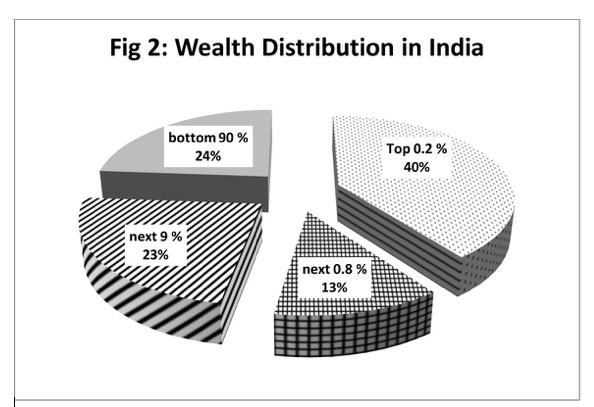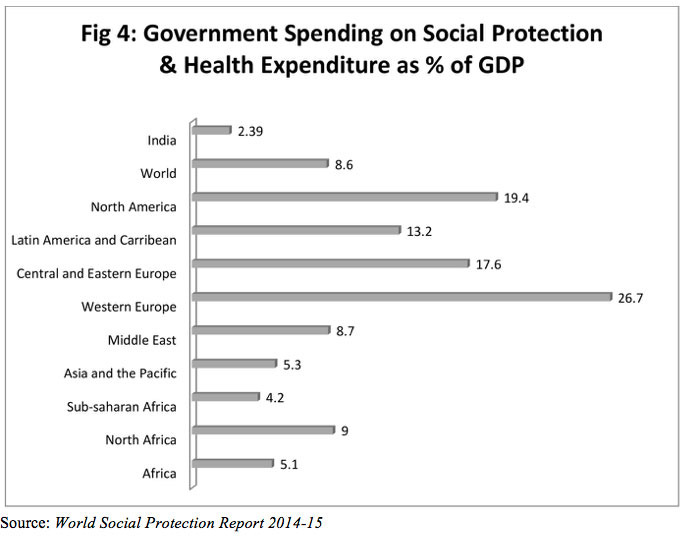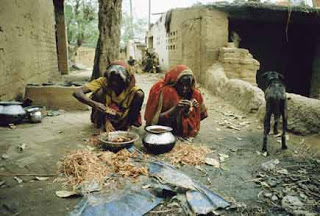India: some basic facts
1. Working populations 2. The indigenous people – tribals 3. The dalits or so-called untouchables 4. The oppressed nations
1. Working populations
(Source: Govt of India, Ministry of Labour and Employment, Labour Bureau, October 2010).India remains predominantly rural — out of a population of 1.2 billion, 72 per cent live in villages.
- 35.9% of the total population are available for work, 63.5% belong to the 15 – 59 age category
- 9.4% of those available for work are recorded as unemployed, 4.9% in the 15 – 59 age group
Categories in percentage of working population:
a. Fields of work
- 46% – 52% agricultural
- 34% service sector
- 14% industry – dominated by textiles
b. Types of work
- 39.3% are casual labour (mostly agricultural, followed by construction work)
- 16.8% are waged / salaried (mostly manufacturing, followed by community services)
- 43.9% are self-employed (mostly agricultural, followed by wholesale and retail sales
c. Types of enterprises
- 65.8% work in enterprises having less than 10 worker
- 43.6% are employed in seasonal or ad hoc type of enterprises
A large no of people are engaged in pre-capitalist mode of productions.
************************************************
From: Aspects of India’s Economy, No 64, December 2016

From: Aspects of India’s Economy, No 64, December 2016

From: Aspects of India’s Economy, No 64, December 2016
Figure no’s same as the source.
India’s spending on defence
India was set to push the UK from the number five spot for spending on defence by 2018
| List by the Stockholm International Peace Research Institute 2016 Fact Sheet (for 2015)[1] |
||||||||||||||||||||||||||||||||||||||||||||||||||||||||||||||||||||
|
2. The indigenous people – tribals
(8.2% of the population, mostly landless peasants)
India’s Supreme Court judge condemns ‘historic injustice’ of tribal peoples: 21 January 2011
Two of India’s Supreme Court judges have passed a groundbreaking judgement recognising India’s tribal people as the nation’s ‘original inhabitants’ and strongly condemning their ‘historic injustice’.
Judges Gyan Sudha Misra and Markandey Katju were hearing an appeal case regarding the stripping, beating and parading naked of a Bhil tribal woman for having had a relationship with a man of ‘higher’ caste. The judges proclaimed that the sentences given to the men involved were too lenient and that the crime was ‘shameful, shocking and outrageous’ and ‘totally unacceptable in modern India.’
The judges praised the tribes of India who ‘have managed to preserve many of their tribal customs despite many oppressions and atrocities from other communities’. They recognised explicitly that the country’s tribal people, or adivasis, are ‘descendants of the original inhabitants of India’, unlike the remaining 92% of the population who are ‘descendants of immigrants’. The official Indian government position has been that all its citizens are ‘indigenous’ not just the adivasis.
The Bhil woman’s case was examined in the context of ‘thousands of years’ of ‘terrible oppression and atrocities’ towards the country’s adivasi people. The judges blamed the ill-treatment of adivasis on the commonly held view of tribal people as ‘inferior’.
‘The mentality of our countrymen towards these tribals must change, and they must be given the respect they deserve as the original inhabitants of India. … The injustice done to the tribal people of India is a shameful chapter in our country’s history. … They were slaughtered in large numbers, and the survivors and their descendants were degraded, humiliated, and all kinds of atrocities inflicted on them for centuries. They were deprived of their lands, and pushed into forests and hills where they eke out a miserable existence of poverty, illiteracy, disease.’
The judges warned that the injustice suffered by the adivasis is not yet a thing of the past and that ‘now efforts are being made by some people to deprive them even of their forest and hill land where they are living, and the forest produce on which they survive.’ The impacts of being removed from their land can be devastating for tribal communities.
From: survivalinternational.org
3. Dalits or so-called untouchables:
India’s apartheid
(16.2% of the population)
To be born a Hindu in India is to enter the caste system, one of the world’s longest surviving forms of social stratification. Embedded in Indian culture for the past 1,500 years, the caste system follows a basic precept: All men are created unequal. The ranks in Hindu society come from a legend in which the main groupings, or varnas, emerge from a primordial being. From the mouth come the Brahmans—the priests and teachers. From the arms come the Kshatriyas—the rulers and soldiers. From the thighs come the Vaisyas—merchants and traders. From the feet come the Sudras—laborers. Each varna in turn contains hundreds of hereditary castes and subcastes with their own pecking orders.
A fifth group describes the people who are achuta, or untouchable. The primordial being does not claim them. Untouchables are outcasts—people considered too impure, too polluted, to rank as worthy beings. Prejudice defines their lives, particularly in the rural areas, where nearly three-quarters of India’s people live. Untouchables are shunned, insulted, banned from temples and higher caste homes, made to eat and drink from separate utensils in public places, and, in extreme but not uncommon cases, are raped, burned, lynched, and gunned down.
4. The oppressed nations
8.64 millions of India’s 67.76 million tribals live in the eight north-eastern states of India. They are Sikkim, Mizoram, Arunachal Pradesh, Assam, Manipur, Nagaland, Meghalaya and Tripura. The region is close to many international borders e.g. Myanmar, China, Bhutan, Nepal and Bangladesh.The land with its natural beauty and cultural heritage has always topped the list of an ideal destination for travellers as well as colonialists looking for its natural resources. Different ethnic groups and tribals have their own culture and tradition and all speak their own tribal languages. This has made Northeast India one of the most culturally diverse regions of the world. Each tribal community has their unique way of living. Tribal people mostly live and earn through the hills and forest areas.
Their history shows that one cannot take the mainstream view of the recent liberation struggles being simply religious or cultural or economic. The effort to control the resources is basic to it. It finds an expression in terms of nationality, identity and ethnicity. The tribals refuse to accept the depletion of their resources caused by the commercialisation of forest and agricultural produce.
The phenomenon goes back to the days of British colonialism and three Anglo-Burmese wars (1824-1885).
The ethnic consciousness that grows from this encounter with the dominant cultures and exploitation leads to identity expansion or several groups merging to expand their identity without giving up their individuality. In this process they also develop a belief in a common origin. Apart from commercialisation of their resources, most struggles in the north-east are in reaction to the oppressive homogenising trend of the dominant “one State one nation” thinking of the Indian State and the tendency “to take the degreee of Aryanisation as the measure of Indianisation”.
The struggles in the north-east of India are struggles for national self-determination of oppressed nations.

No comments:
Post a Comment